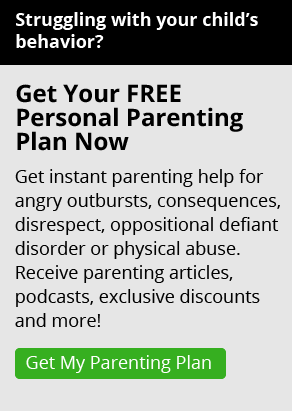Making excuses may start innocently enough—kids don’t like consequences, and they make excuses to get out of them. It’s annoying, but we tolerate it.
But over time, children may use excuses as a way to avoid responsibility. And the more a child avoids responsibility, the more excuses are needed to get by in the world.
And as your child grows up, the real world won’t accept excuses for their behavior. Their high school and college teachers won’t accept them, their boss won’t accept them, their spouse won’t accept them, and the legal system won’t accept them.
And that’s why you shouldn’t accept them either—because your role as a parent is to prepare your child for the real world.
As a therapist who worked with tough adolescents in group homes for years, I heard every excuse you can imagine.
Instead of getting sucked into an argument, we focused on getting the kids to take responsibility. Sometimes we would catch kids in the act of sneaking out at night, and they’d still try to tell us it wasn’t their fault.
Our method of dealing with the situation was to do the following:
- Describe the situation objectively: “You were caught sneaking out after lights out.”
- State the problem simply and clearly: “It’s against the rules, and it’s a safety concern.”
- Give a consequence: “You won’t be allowed to go on the group outing to the mall tomorrow.”
As the adults in charge of these teens, we did not get into all the reasons why they had misbehaved. And we didn’t discuss morality. Instead, we just handled the situation in a businesslike way.
Here are nine tips to get your child to stop making excuses and take responsibility for themselves.
1. Catch Your Child in the Excuse and Call Them Out
One of the best things you can do is catch your child when they’re blaming someone—or something—for their actions and then call them out. You can say:
“It sounds like you’re blaming your friend for the fact that you came home past curfew without calling me.”
Turn it around and let your child know that no matter what, in your eyes, they’re accountable for their choices and behavior.
2. Focus on Your Child’s Behavior, Not the Excuse
Focus on the behavior and not the fact that your child made an excuse. Identify the problematic behavior. Is it that your son hits his siblings? Or that your daughter didn’t do her homework?
Once you identify the behavior, you can name it and then get your child to look at it. Be clear about what you saw and what happened.
Don’t let them get away with changing the subject because, if you do, they won’t accept responsibility for their behavior.
3. Keep the Conversation Simple
Keep the conversation simple. Name the behavior that is the problem, name the bad choice, and then talk with them about what a better choice would look like.
Don’t make the conversation about morality. If you do, you are likely to lose your child in your words. And you’ll lose the focus on where it should be—the behavior.
4. Review the Incident With Your Child
When things are calm, review the incident. Here’s an example conversation:
You: “Let’s pretend someone had a video camera and could watch what was going on. What would they have recorded just now?”
Your child: “My sister took my tablet, so I hit her.”
You: “There were lots of other things you could have done other than hit her. What can you do differently next time so you don’t get in trouble?”
Your child: “I don’t know. I guess I could put my stuff on a higher shelf so she can’t get to it.”
If your child can’t come up with an idea, you can help them get started.
You: “You could also come and tell me about it, and I’ll take care of it.”
This works well with kids and gives you—and your child—a more objective way to look at the situation.
Role-playing can also be helpful here. During role-play, you can practice what they can do next time. You can give them the words to use and the actions to take. Role-playing is a powerful tool for changing behavior. You can think of it as a way to rehearse what your child will do the next time they’re inevitably faced with a similar situation.
5. Model for Your Child How to Take Responsibility
Your role as a parent is to set limits, teach, and coach your child. Part of that is to actively teach what is appropriate and what isn’t through role modeling.
If you mess up, don’t make an excuse. Instead, own the mistake in the same way you would want them to. It’s okay to say to your child:
“When I came home from work tonight, I was cranky. I could’ve handled it better. I didn’t need to yell. I’m sorry. Next time I’ll take some time to relax before I walk through the door after a bad day.”
This is modeling what it looks like to take responsibility. In addition, you’re letting your child know how you will handle it in the future.
6. Challenging Your Child’s Excuse Making Every Time
Commit yourself to the process of challenging your child’s excuses and faulty thinking. Just because you’re able to cut past the excuse to the behavior one time doesn’t mean the behavior will stop or that your child won’t find another way to deflect or change the subject. Keep at it.
And when they successfully take responsibility, notice it, and call it out. Let them know you are pleased that they didn’t make an excuse.
7. Be Calm and Businesslike
Be calm and businesslike so that you don’t get emotional and get dragged into a fight. This will ensure that you don’t lose sight of the goal of teaching your child to be more responsible.
Sit with your child and discuss what happened. Review the behavior. You say can this to your child:
“You pushed your brother. There’s no excuse for abuse in our home. What can you do instead the next time you get angry with your brother?”
When you deliver a consequence, you also need to be businesslike. And be sure it’s an effective consequence. As my husband, James Lehman, would always say, “You can’t punish your child into good behavior.” Instead, you need to use effective consequences that motivate your child to behave better.
For more on effective consequences, I highly recommend the article How to Give Kids Consequences That Work.
8. Have Your Child Make Amends
Once your child acknowledges their mistake, have them make amends if the situation warrants it.
What’s the difference between making an apology and making amends? An apology shows remorse for an action you took, which is important. But making amends goes further. Making amends means correcting the mistake.
You don’t make amends with words. You make amends by replacing the toy you broke or doing your sibling’s chores for a day. Amends makes things right and shows that your apology isn’t just empty words.
Making amends is taking responsibility, and it is the exact opposite of making excuses. It’s difficult for a child to do initially, but it gets easier once they learn to do it. And, if all goes well, they won’t be doing it very often because they will have improved their behavior.
9. Remind Your Child They Have Choices
It’s empowering to know that we all have choices in life—and that goes for your kids, too. They’re choosing either to follow the rules or not to follow the rules. At any given moment, they choose between right behavior and wrong behavior.
If your teen daughter is with friends and realizes she will be late for curfew, she has the choice to text you and let you know or call you to ask for a ride. Blaming her friends for her inability to get home on time is not a valid excuse. She’s not a victim. She has the power to control her actions each time she steps out of the house.
Remember, the more your child takes ownership of their actions, the more empowered and responsible they will become. Remind them of this often.
Related Content:
How to Create a Culture of Accountability in Your Home
How to Get Kids to Do Chores Without an Argument
About Janet Lehman, MSW
Janet Lehman, MSW, has worked with troubled children and teens for over 30 years. A veteran social worker, she specializes in child behavior issues — ranging from anger management and oppositional defiance to more serious criminal behavior in teens. She is co-creator of The Total Transformation® Program, The Complete Guide To Consequences™, Getting Through To Your Child™, and Two Parents One Plan™.
You must log in to leave a comment. Don't have an account? Create one for free!
-
Katy Reeves
Thank You for this article!!! It was great. -
Katy Reeves
Thank You for this wonderful article!! My son is quite a challenge lately...and he's only 4!!! This article helped me understand better how to help him when he makes poor choices. I like the idea of either making Appologies and Ammends....ammends are much longer lasting than just a simple appology.More I will try to talk to him about how he can make Ammends w/ his Father for lying about being sick so he didn't have to go to school. -
Kenneth Hardy
Great article! How can this strategy be used by parents to discover if their child's naturally gift for defense signals a destiny to become the greatest defense lawyer?



